Final report for OS17-104
Project Information
Zucchini squash, Cucurbita pepo L., is a high value vegetable crop in Florida. Damage from aphid and whitefly pests are major problems for many growers around the state. Information on organic pest management, particularly the efficacy of products and strategies available, is very limited and sometimes unavailable for many growers. The purpose of this study was to evaluate the biological control agent Amblyseius swirskii in a diversified planting system to determine their effectiveness in managing aphids and whiteflies in organic squash. The specific objectives were to 1) evaluate the effect of planting multiple varieties of squash on arthropod pests and disease incidence compared with pure stands of a single squash variety, and 2) determine the effect of intercropping sweet alyssum with squash on arthropod pests and natural enemy populations. The experiment was conducted on a certified organic farm. The experimental design was 2×2 factorial plot design with four replicates evaluating 1) single squash variety planting vs. mixed squash variety planting, and 2) the effect of sweet alyssum on pest and natural enemy populations. Amblyseius swirskii was released into the experimental plots, and experimental treatments were compared to a grower’s standard control of mixed squash variety planting with no biological control or companion plant. Whitefly pressure was observed to be greatest in single variety plantings of squash, and there were fewer immature whiteflies observed on squash plants intercropped with sweet alyssum in both single variety and mixed variety plantings. Physiological disorders were also higher in the single variety plantings. Orius and A. swirskii populations were greater on squash in the single variety plantings. Mixed variety plantings and intercropping with sweet alyssum could be effective at reducing pest populations and pest symptoms on squash plants.
The overall purpose of this study was to evaluate the biological control agent Amblyseius swirskii in a diversified planting system to determine their effectiveness in managing aphids and whiteflies in organic squash.
The specific objectives were to 1) evaluate the effect of planting multiple varieties of squash on arthropod pests and disease incidence compared with pure stands of a single squash variety, and 2) determine the effect of intercropping sweet alyssum with squash on arthropod pests and natural enemy populations. This project will aid in identifying reduced-risk tools that are compatible with beneficial insects and contribute to developing a comprehensive IPM program for controlling economic pests of organic squash.
Cooperators
Research
In this study, several IPM strategies were evaluated to reduce arthropod pests and disease incidence while increasing marketable yield in organic squash production. The experiment was conducted on a certified organic farm in Hawthorne, FL during the spring of 2018 from 6 April 2018 to 4 June 2018. Each sampling plot measured 7.6 × 3.1 m and contained two rows. Plots within a block were separated by 6 m of bare soil and blocks were separated by 3 m of bare soil. Planting beds were raised 30 cm and received a drip irrigation line. Squash was planted in a single row every 61 cm. A blended dry granular fertilizer compliant with organic systems [Nature Safe (10-2-8) (Griffin Industries LLC, Cold Spring, KY)] was incorporated into the soil at planting and followed by a second application of the same fertilizer four weeks after planting.
The experiment was 2x2 factorial plot design with four replicates. The first factor compared (1) a single variety planting of ‘Zephyr®’ yellow summer squash (Johhny's Selected Seeds, Winslow, ME) and (2) a mixed planting of multiple squash varieties. Squash varieties included 'Zephyr®', 'Eight Ball®' zucchini squash, ‘Sunburst®’ pattypan yellow summer squash, (Johhny's Selected Seeds, Winslow, ME) and winter squash varieties including ‘Thelma Sanders®’ sweet potato squash and ‘Butterscotch®’ butternut squash. Squash seeds were sown in trays and transplanted after four weeks.
The second factor compared the presence or absence of sweet alyssum intercropped with squash in 1.5 m strips at the ends of each row. Sweet alyssum was sown in trays and transplanted after six weeks. Amblyseius swirskii was released in all experimental plots at a rate of 200/m2 approximately 2.5 wk after planting squash to ensure that adult whiteflies have sufficient time to colonize and reproduce. Experimental plots were compared to the grower’s standard (control) of planting multiple squash varieties (the same varieties listed above) in the same field without a biological control (A. swirskii) or an intercrop (sweet alyssum). The control field was adjacent to the experimental field, and four transects (replicates) measuring 7.6 × 3.1 m were flagged in the control field to compare to the experimental plots.
Alate and apterous aphids, adult and immature whiteflies, disease incidence, natural enemies, plant size, and marketable yield in each plot were monitored on squash plants and recorded for a six-week period. Alate and apterous aphids were sampled weekly from five randomly selected plants in each plot using the leaf-turn method as detailed in Nyoike and Liburd (2010). Alate aphids were also monitored using blue-colored pan traps (Solo™, Lake Forest, IL) placed in each plot that were secured within tomato cages and contained approximately 250 cm3 of 5% detergent solution. The contents of the traps were collected weekly and taken back to the laboratory where the number of alate aphids were counted and recorded.
Adult whiteflies were monitored using yellow sticky Pherocon® AM unbaited traps (Great Lakes IPM, Vestaburg, MI) placed in each plot that were mounted on wooden stakes and placed just above the plant canopy. Traps were left in the field for 72 h, after which the number of adult whiteflies per trap were counted at the laboratory. To count immature whiteflies, three of the five leaves used for sampling apterous aphids were excised and brought back to the laboratory. Three 3.14-cm2 leaf discs were taken from each leaf using a cork borer. Whitefly nymphs were counted using a dissecting microscope and the total number of all immature stages were recorded.
Visual observations of viral symptoms and incidence were monitored each week by recording the number of plants in each plot showing virus symptoms. Leaves were collected and assayed for the most commonly occurring insect-transmitted cucurbit viruses by a double antibody sandwich enzyme-linked immunosorbent assay (DAS-ELISA) or using polymerase chain reaction (PCR). Squash silverleaf (SSL) was also monitored each week by randomly selecting nine plants from each plot and scoring SSL incidence with an arbitrary scale adapted from Yokomi et al. (1990) that ranges from 0, which indicates a healthy plant, to 5, which indicates a plant with all leaves completely silvered.
Natural enemies were monitored each week using in situ counts and recording the numbers of predators and parasitoids found on five randomly selected plants from each plot. Natural enemies were also monitored using the yellow sticky trap used to monitor adult whiteflies. Squash plant height and width were measured each week from six randomly selected plants in each plot. Squash was harvested from each plot, and marketable fruit was weighed in the field every other day until the end of the season.
Aphid, whitefly, natural enemy, disease incidence, and plant measurement data was analyzed by a repeated measures analysis of variance procedure (ANOVA; PROC GLM, SAS). Marketable yield data was summed over the entire growing season and analyzed using ANOVA (PROC GLM, SAS). Treatment means were separated by least significant differences (LSD) test where ANOVA indicates a significant effect on the model by factor, and differences among treatments will be considered significant if P = 0.05.
The number of adult whiteflies sampled by in situ counts differed by treatment (F = 4.83; df = 4, 570; P = 0.0008), over time (F = 34.82; df = 5, 570; P ≤ 0.0001), and there was a marginal interaction effect (F = 1.51; df = 20, 570; P = 0.0704) such that there were treatment differences in the fifth and sixth weeks of sampling. There were fewer adult whiteflies on squash plants in the grower’s standard control mixed variety planting and the experimental mixed plot interplanted with sweet alyssum compared with the single variety planting without sweet alyssum (Fig. 1). There were also fewer adult whiteflies on squash plants in the grower’s standard control mixed variety planting and the experimental mixed plot interplanted with sweet alyssum compared with the experimental plot without sweet alyssum (Fig. 1).
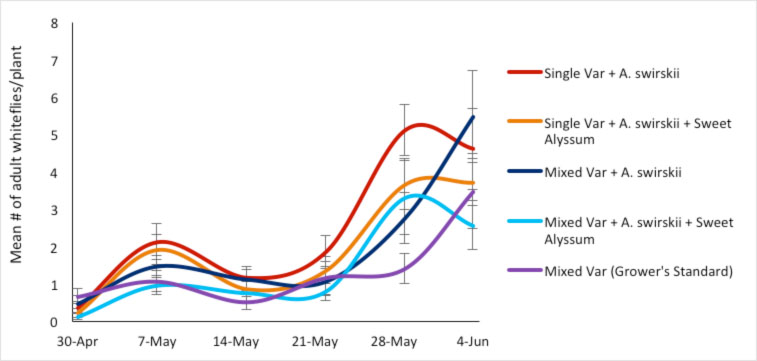
Fig 1. Mean (±SE) number of adult whiteflies sampled by in situ counts on squash plants.
The immature whitefly counts from leaf-disc assays differed by treatment (F = 8.56; df = 4, 1050; P ≤ 0.0001), over time (F = 19.11; df = 5, 1050; P ≤ 0.0001), and there was an interaction effect (F = 2.06; df = 20, 1050; P = 0.0039) such that there were treatment differences in the fourth and sixth weeks of sampling. There were fewer immature whiteflies on squash plants in the grower’s standard control mixed variety planting compared with all experimental field plots (Fig. 2). There were also fewer immature whiteflies on squash plants in the both mixed plots and single variety plots interplanted with sweet alyssum compared with the plots without sweet alyssum (Fig. 2).
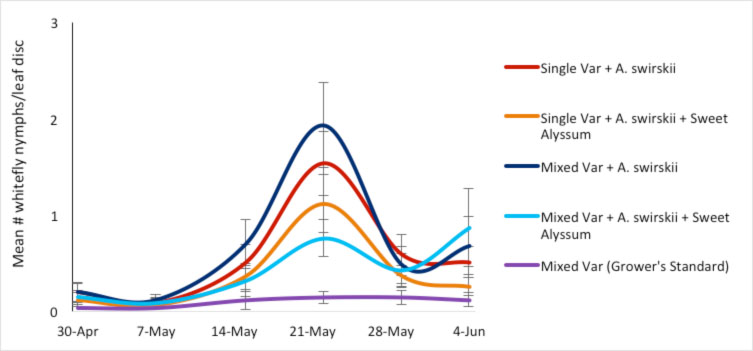
Fig 2. Mean (±SE) number of immature whiteflies sampled from 3.14-cm2 leaf discs.
The number of aphids sampled by in situ counts differed over time (F = 31.32; df = 5, 570; P ≤ 0.0001), with no treatment (F = 0.77; df = 4, 570; P = 0.5424) or interaction effect (F = 0.96; df = 20, 570; P = 0.5128). The number of aphids in pan traps also differed over time (F = 2.82; df = 5, 89; P = 0.0206), with no treatment (F = 0.10; df = 4, 89; P = 0.9820) or interaction effect (F = 0.96; df = 20, 89; P = 0.5108).
Virus incidence was low and there was no significant difference among treatments (F = 0.37; df = 4, 88; P = 0.8319). Alternatively, SSL ratings differed by treatment (F = 34.00; df = 4, 690; P ≤ 0.0001), over time (F = 59.57; df = 5, 690; P ≤ 0.0001), and there was an interaction effect (F = 11.02; df = 20, 690; P ≤ 0.0001) such that there were treatment differences from the third to the sixth week of sampling. SSL ratings were lower in the grower’s standard control mixed variety planting compared with all experimental field plots (Fig. 3). SSL ratings were also lower in the both mixed plots compared with the single variety plots (Fig. 3).
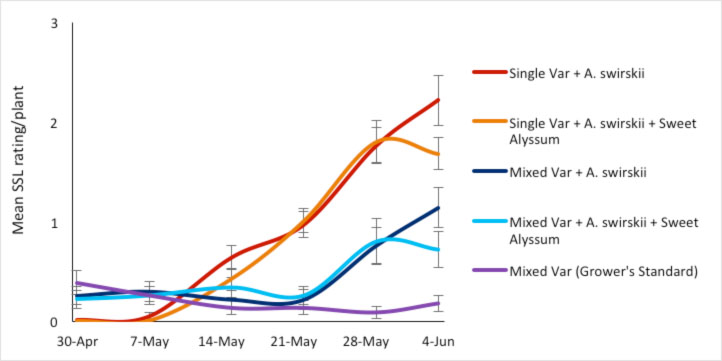
Fig 3. Mean (±SE) squash silverleaf (SSL) disorder symptom rating per squash plant.
The natural enemies observed by in situ counts included minute pirate bugs, Orius spp. (Hemiptera: Anthocoridae); hover flies (Diptera: Syrphidae); green lacewings (Neuroptera: Chrysopidae); lady beetles (Coleoptera: Coccinellidae); ground beetles (Coleoptera: Carabidae); spiders (Araneae); and the aphid parasitoid Aphidius spp. (Hymenoptera: Braconidae). The number of Orius sampled by in situ counts differed by treatment (F = 3.83; df = 4, 570; P = 0.0044), over time (F = 14.35; df = 5, 570; P ≤ 0.0001), and there was an interaction effect (F = 2.34; df = 20, 570; P = 0.0009), such that there were treatment differences the fourth and fifth weeks of sampling. There were more Orius on squash plants in the experimental mixed variety plot interplanted with sweet alyssum and both single variety planting treatments compared with the grower’s standard control and the mixed variety planting without sweet alyssum (Fig. 4). The number of Amblyseius swirskii observed on assayed leaf discs also differed by treatment (F = 4.17; df = 4, 1050; P = 0.0024), over time (F = 6.05; df = 5, 1050; P ≤ 0.0001), and there was an interaction effect (F = 1.55; df = 20, 1050; P = 0.0588), such that there were treatment differences the third and fifth weeks of sampling. More A. swirskii were observed on squash leaves in the single variety planting treatments compared with the mixed variety plantings and the grower’s standard control (Fig. 5).
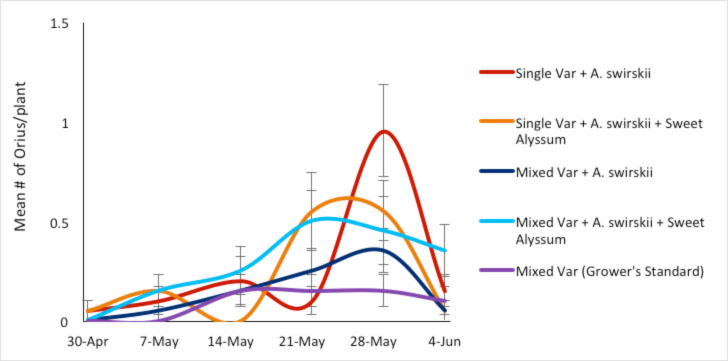
Fig 4. Mean (±SE) number of Orius sampled by in situ counts on squash plants.
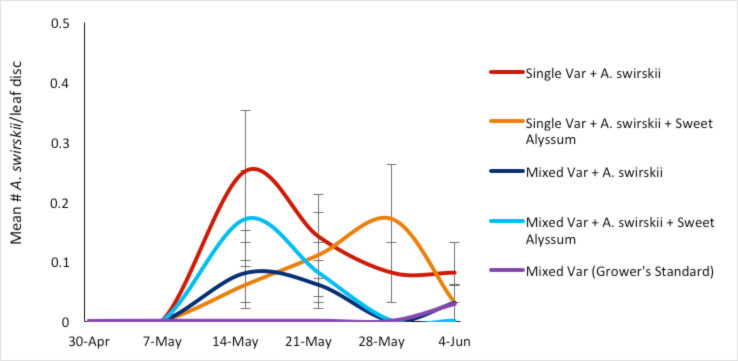
Fig 5. Mean (±SE) number of Amblyseius swirskii sampled from 3.14-cm2 leaf discs.
Squash plants were larger in the grower’s standard control mixed variety planting and the experimental mixed plot interplanted with sweet alyssum compared with the mixed variety planting without sweet alyssum and both single variety plantings (Height: F = 5.22; df = 4, 575; P = 0.0004; Width: F = 13.29; df = 4, 575; P ≤ 0.0001) (Fig. 6). However, marketable yield was greater in both single variety plantings compared with both experimental mixed variety plantings (F = 2.96; df = 4, 15; P = 0.0551) (Fig. 7).
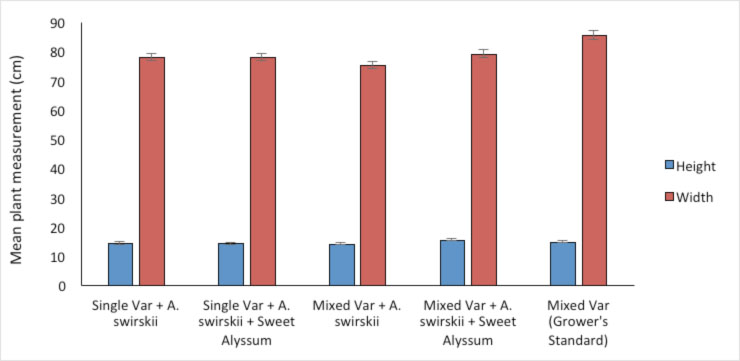
Fig 6. Mean (±SE) height (cm) and width (cm) of squash plants sampled over a six-week period.
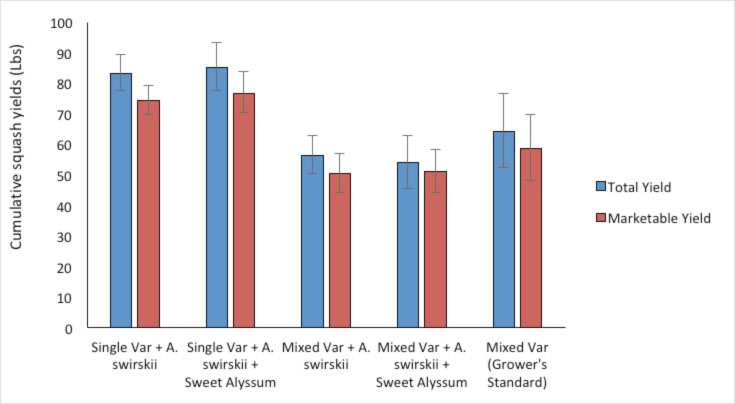
Fig 7. Total marketable squash yield (lb) (±SE) harvested over a six-week period.
Whitefly pressure was observed to be greatest in single variety plantings of Zephyr squash. There were fewer immature whiteflies observed on squash plants interplanted with sweet alyssum in both single variety and mixed variety plantings, suggesting that the presence of sweet alyssum had a positive effect on reducing whitefly populations on squash. There also were greater numbers of natural enemies, including Orius and A. swirskii on squash in the single variety plantings, likely because the densities of whiteflies were also greater in these plots. Furthermore, SSL ratings were higher in the single variety plantings. Therefore, mixed variety plantings and intercropping with sweet alyssum could be effective at reducing pest populations and pest symptoms on squash plants.
We did not observe differences in aphid densities between treatments. Aphid populations were high during the beginning of the season and present throughout the farm; therefore, it was difficult to observe any treatment effects. Overall, marketable yields were greater in the single variety plantings of Zephyr, which is a high yielding squash variety that produces all season-long compared with some of the other varieties used in the multiple variety plantings (i.e., Eightball, Sunburst, butternut squash varieties). Observations of a significant reduction in pest densities and virus incidence in the mixed varieties treatment suggest that this could be an effective strategy; therefore, future research should incorporate more high yielding varieties in the multiple variety treatments.
Educational & Outreach Activities
Participation Summary:
A workshop and a seminar including the project results were conducted during the 2018 Organic Summit (Gainesville, FL). During these activities approximately 20 agricultural professionals and farmers were trained on how to identified major insect pests and natural enemies commonly found on squash and other cucurbit crops.
A presentation including the project outcomes was given during the 2019 Tri-State Cucurbit meeting (Quincy, FL).
Learning Outcomes
Farmers reported changes in knowledge, attitudes, skills and/or awareness as a result of their participation.
The farmer reported interest in using sweet alyssum in future plantings to enhance biological control and habitat diversity on the farm.
The farmer demonstrated great interest in the project in that it evaluates the effectiveness of alternative (non-chemical) strategies for pest management and supports his desire to utilize minimal chemical inputs.
Project Outcomes
The development of an IPM program utilizing biological and cultural controls to manage economic pests in organic squash is a sustainable alternative to conventional spraying techniques. The goal of this project was to develop an integrated approach that is not solely reliant on frequent pesticide applications but to build a truly integrated program that utilizes cultural and biological strategies. Our project is a model program for other farmers in the region. We took advantage of our monitoring data to implement sustainable management tactics. These tactics helped to reduce selection pressure to manage resistance to common insecticides used against aphids and whiteflies. The number of products available for management of aphids and whiteflies in organic squash production, primarily pyrethrins (PyGanic®) and insecticidal soap (M-Pede®), are limited compared with conventional production. Over time there will be issues with the development of insecticide resistance in pest populations if individuals are continuously exposed to the same products. This can be troublesome in the organic industry if more tools (tactics) are not available for growers to use. By utilizing a more integrated approach as an alternative to weekly chemical insecticide sprays to manage pests in organic squash production, it is possible to significantly reduce spraying output and frequency; therefore, saving money (cost of pesticides), labor, and minimizing the impact on the environment. Furthermore, identifying reduced-risk tools that are compatible with beneficial insects has improved IPM of aphids and whiteflies in squash. Overall, this project aid in developing a comprehensive IPM program while controlling economic pests of organic squash in the southeast. It served to maintain the integrity of the environment, promote grower-worker safety and health, increase profits and ensure the future of organic cucurbit production and the high value market it offers to Florida and the rest of the country.
Sweet alyssum had a positive effect on reducing whitefly populations when intercropped with squash. Whitefly pressure and SSL ratings were higher in plantings without sweet alyssum. Therefore, mixed variety plantings and intercropping with sweet alyssum is effective at reducing pest populations and pest symptoms on squash plants.
Observations of a significant reduction in pest densities and virus incidence in the mixed varieties treatment suggest that this is an effective strategy to be adopted in an IPM program for organic cucurbit production.